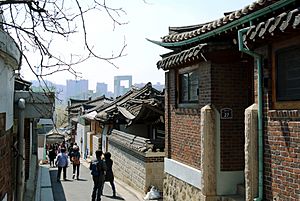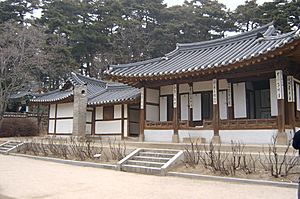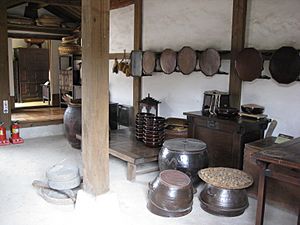Hanok facts for kids

Hanok is a special kind of house from Korea. It's built in a traditional Korean style of architecture. These beautiful homes show off Korea's history and culture.
Contents
What Makes Hanok Special?
A main feature of Hanok houses is how they are heated and cooled. They use a mix of two systems:
- Ondol: This is a Korean under-floor heating system. It keeps the house warm in winter.
- Wooden floor: This part helps keep the house cool in summer.
This combination is perfect for Korea's climate. Korea has both a continental climate (cold winters) and an oceanic climate (warm, humid summers). The Hanok design helps people stay comfortable all year round.
Hanok Shapes and Styles
Hanoks have different shapes depending on where they are built and who lives in them.
Shapes in Different Regions
Hanoks look different in various parts of Korea:
- Northern Korea: In the colder northern areas, Hanoks often have several parts or "wings." These wings might be shaped like a square or the letter L. This design helps block the wind and keeps the house warm. These homes also have low roofs.
- Southern Korea: In the warmer southern areas, Hanoks usually have just one main part. They also have more wooden floors. This design lets air flow easily through the house, keeping it cool.
Shapes for Different Classes
The design of a Hanok also showed the social class of the people living there:
- Upper-class Hanoks: These homes often had roofs made of tiles, called giwa. They were built not just as homes, but also to look very beautiful and fancy.
- Lower-class Hanoks: These houses usually had roofs made from rice-straw, called choga. They were simpler and built more for practical living.
Images for kids
-
Giwa (기와) drawn by Danwon
-
Korean traditional Bark shingled house, Neowajip or Gulpijip (굴피집) in Gangwon Province
-
Hanoks in Seoul
-
Hasadang Hall (built 1461) located in Suncheon, South Jeolla Province
See also
 In Spanish: Hanok para niños
In Spanish: Hanok para niños












